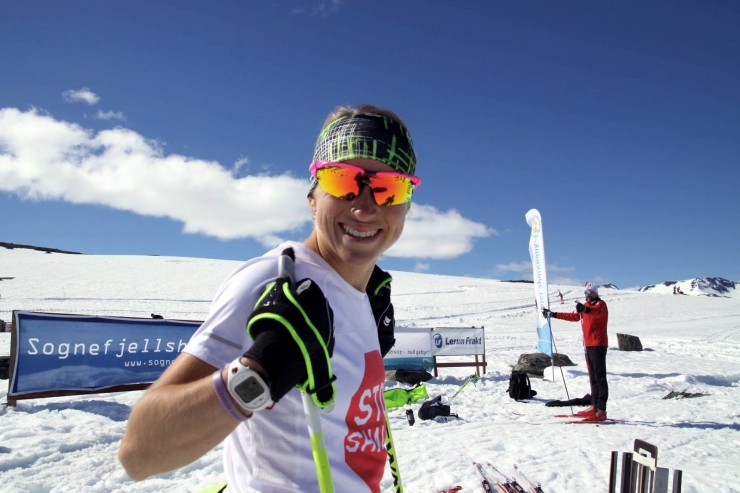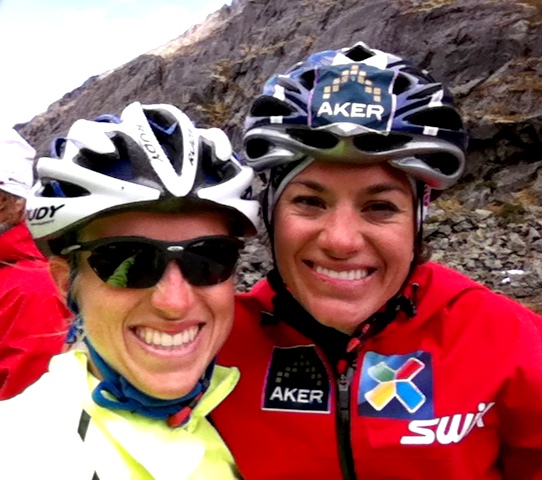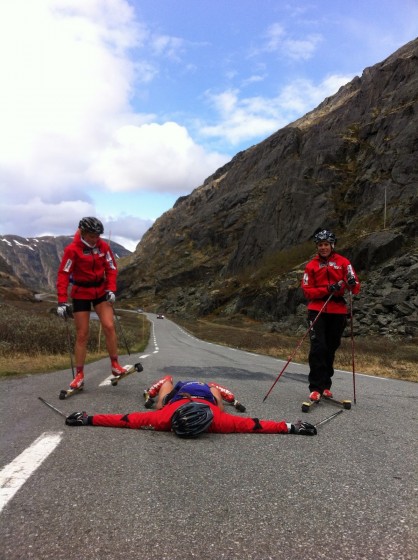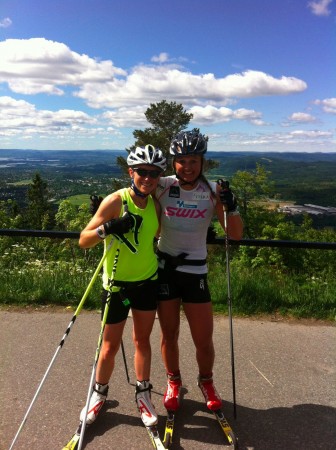
Last July, Liz Stephen made no secret of the fact that she had specific goals for the 2012/2013 season. The 26-year-old U.S. Ski Team member wanted a top-10 at World Championships, to be in the Red Group all season and to crack the top-10 in a regular World Cup. More than anything, she wanted a relay podium.
“You and your teammates on a podium together sums up why I do sport,” Stephen said then. “We’ve talked about relay goals and we want to podium at the Olympics.”
If you followed Stephen’s season, you know what came next. She was the third leg of the U.S. women’s relay team in Gällivare, Sweden, when they placed third.
Check.
In February, Stephen was fifth in the 10 k individual freestyle at World Championships, a huge breakout performance for her.
Check.
In the Tour de Ski, during the brutal climb up the Alpe Cermis in the last stage, she was second in time-of-day. In the Sochi, Russia, Olympic test events, Stephen finished eighth in the 15 k skiathlon. A few months later she skied to a gutsy ninth place in the 30 k freestyle mass start in Oslo, Norway. She was in the Red Group all season.
Check, check, check, check.

As any athlete can tell you, goal setting is an integral part of pre-season preparation. Sports psychology canon posits that goals should be specific, measurable and difficult-but-achievable. Given the no-nonsense nature of her goals last year and her achievement of almost all of them, it may come as a surprise that Stephen once had a strong aversion to setting them.
“It’s something I’ve learned to do over the last few years,” she said on the phone from Park City, Utah, last week. “Setting a result-goal used to be a very scary thing that I used to avoid at all costs, because I was convinced it wasn’t going to help my skiing and it would just stress me out. I just love to ski and that’s why I was doing it.”
Clearly, Stephen came around on the concept. The last twelve months, after all, have been a strong demonstration of the power goal setting can have.
“It’s good to set the result goals and the outcome goals so you can have a path as to where you want your training to lead,” she said. “I’m certainly focused on the relay and the 30 k and now I can shape my training this summer and fall, and the season, around making sure that those are the highest priority races for me.”
Stephen’s goals for next year represent her desire for another jump forward. She wants to finish in the top ten at the Tour de Ski and becoming a regular top-ten World Cup skier. Her biggest focus of the season is the Sochi Olympics, where she wants a medal in the relay and the 30 k freestyle.
“We’ll see what happens,” Stephen said. “It’ll be fun.”

In pursuit of those goals, Stephen has traveled roads both new and familiar this summer. She reunited with her USST teammates in Bend, Ore., for a camp in May and briefly returned home to Park City thereafter, but from there skiing took her down a unique path. Earlier this month, Stephen took off for Scandinavia to begin an overseas camp with the Norwegian National Team at an invitation from Astrid Jacobsen, the 2007 World Champion in the classic sprint.
“During the season I’d kind of been chatting with Astrid and she was like, ‘You should join one of our camps this summer,’” Stephen said. “And I was like, ‘Really?’”
Before departure, Stephen first explored the idea of joining the Norwegians at Seiser Alm for the team’s upcoming dryland block. When she learned that camp was full, USST women’s coach Matt Whitcomb got in touch with Norwegian women’s coach Egil Kristiansen to ask about their on-snow Sognefjell camp in southern Norway. They had room, and Stephen booked her plane ticket.
“After some thought they said, ‘Yeah,’ — there was room on Sognefjell for me, and they’d be happy if I’d join them,” Stephen said.
And just like that, she was off to Norway for a week of training with the nation that brought home 19 medals from World Championships last winter. Stephen lived and trained with the women’s squad by the snowfield and joined them for both on-snow and rollerski sessions as if she was part of the team.
The Norway trip was Stephen’s third consecutive summer traveling abroad; for the past few summers she and teammate Kikkan Randall have trained with Swedish power couple Emil Jönsson and Anna Haag. In 2012 the entire U.S. women’s team traveled to Sweden to train with the Swedish national team. This month, Stephen returned to Sweden in the second segment of her trip for another visit with Jönsson and Haag.

But this year was Stephen’s first time training with Norway, and American invitations to train with the powerhouse ski nation are rare. Her weekly blog updates throughout the trip made her seem comfortably at home while living and training with Marit Bjørgen, Therese Johaug, Heidi Weng & Co., but Stephen admitted to no small amount of nerves before meeting her hosts.
“I was telling the girls on my team before I left, what I [was] most nervous about was that first dinner, where you show up and you’re just kind of the only one there,” she said. “You don’t speak their language, you have no idea what to expect.”
Within the first 20 minutes of being there, however, Stephen’s fears evaporated. “Everyone was over-the-top welcoming and tried to speak English as much as possible with me, and they taught me some Norwegian,” she said.
The welcoming atmosphere continued in workouts. Stephen skied with Johaug, Bjørgen, Jacobsen and the rest of the team, observing the work they did and finding the elements of their training not dissimilar to her own program. This has been a key takeaway from Stephen’s training trips abroad: each time she goes, she finds the difference between European training and her own gets smaller, and now she hardly sees one at all.
“It seems like the first year was really eye-opening, how much Anna was training, and I was a little bit like, ‘Holy crap, this is a lot,’” Stephen remembers. “And I think everyone in the U.S. now has a better idea that there is a lot of training that needs to happen. And so now I go over and it’s kind of nice to see that it’s not anything crazy different from what we’re doing. Everyone’s just training really hard.”

She found this lesson from Sweden to be the same in Norway.
“It’s not just like, ‘Oh, that’s what they’re doing, that’s why Marit wins everything,” Stephen continued. “Marit, she’s training a lot and has been for a long time, and is a really good athlete and works really hard and wants to win. There [are] no alien qualities to these girls, they’re just other people. That’s nice to see and good for the U.S. to hear, too. They’re just people.”
The camp Stephen attended was Norway’s first one of the year, so it didn’t include many head-to-head intensity sessions; athletes did most interval workouts solo in order to go the right pace. But in certain speed sessions everyone skied together, and Stephen said she sprinted with the red-clad train and held her own.
One particular rollerski workout was designed to pit skiers against each other at high speeds and close quarters. A different athlete would begin each interval at the front of a train, and those behind her were tasked with passing each other and the leader before the end of three minutes.
“That was a fun way to do speeds, I thought,” Stephen said. “Egil would say, ‘This time Therese is leading.’ And everyone has to stay behind Therese for the first 30 seconds of the interval. And it’s fast. Like — it’s fast. You’re in the draft, and if you lose the draft then you’re pretty much off the back. After 30 seconds everyone can go by and it’s just a free-for-all — and these are max intervals, so they’re really hard.
“I was happy to be able to stay with the girls, for sure,” she added. “I was nervous for that one, going into it.”
The idea of Johaug and Stephen skiing together is of particular intrigue. The two have a similar style of skiing, dictated in part by their slight but powerful builds. The likeness comes out in skate races that feature challenging ascents — in the final climb of the Tour de Ski, Johaug was the only one to beat Stephen to the top on time-of-day. Their quick tempos served them well as they scampered up the alpine slope and left those churning in higher gears in their dust.
It is where the two are less similar that Stephen finds she can learn the most from Johaug’s skiing. Johaug is a year and a half younger than Stephen. The two first saw each other in competition in 2007 at World Juniors in Travisio, Italy, and since then Stephen has taken notes on Johaug’s style as they have both progessed through the World Cup circuit.
“It’s been fun to watch her get better over the years,” Stephen said. “I certainly look to her for some technique ideas, because we’re both pretty small and she’s learned, over the last couple of years, how to ski the flats really well and be really powerful on the double pole. And she’s an amazing classic skier, which some day I’d like to put together. Trying to learn from her [on Sognefjell] was really fun, and she was really nice and let me follow her around.”
If being a guest of the Norwegian National Team was a learning opportunity for Stephen, the cultural exchange was mutual. She doesn’t think she taught them anything new training-wise, but hopes she managed to “spice up” their camp with a new face and gave them an excuse to practice English. If you hear Norwegians with better post-race interview vocabulary next winter, Stephen may deserve some of the credit.
“One of the area’s they’ve been working on a little bit is with media, and how to say more than just, ‘The race was good, my shape was good.’ So they’ve been practicing English media training a bit this summer,” Stephen said.

The post-race interviews of greatest import are for those who make it to the podium, and Stephen wants to climb those steps this year. At the end of our conversation she repeated the view a teammate recently spoke of regarding the importance of confidence as she moves from one breakout season to a potentially even better one.
“After a good season, the thing you can really take from it is confidence,” Stephen said. “I think in anything…you do everything better if you’re confident in what you’re doing and you enjoy what you’re doing. I think this year we did both of those really well, and now going into next year we can be more confident than ever that we are preparing the right way. Of course barring injury and being healthy, that plays a huge role as well, but I think we can go into next year knowing we’re doing the right things and we’re becoming one of the best ski nations in the world.

“I think with the group of girls we have now, and the guys as well, we can set the goals and expectations now that are realistic, whereas before it was if everything went perfectly we might win a medal,” she continued. “And of course everything has to go pretty darn well to come out of the Olympics with a gold medal, or with any medal, but I think we have many more chances to do so. It will just be a really exciting time.”
When they’ve been together, the USST has talked about Sochi at length this summer, particularly when it comes to the subject of managing the inevitable stress of the Games. With Vancouver under her belt, Stephen hopes the Olympic hype will be easier to manage this time around.
“A big thing will be not letting the stress of the Games kind of wear you down,” Stephen said. “After going to Vancouver I feel like I’m more prepared for what to expect, and hopefully the people who’ve been to the Olympics before can share with the rest of the team some of the stresses that they might encounter so they have time to prepare strategies for things that will go wrong, because are always going to be things that go wrong, or stress you out, or piss you off. There are all these little things you have to learn how to deal with when you’re at a high-stress event like the Olympics. So for me, that’s kind of where I’m heading with my sports psychologist: to come up with ways to make sure I’m not caught off guard with some big issues that might come about.”
Stephen returned to the idea of carrying confidence into the Games as a way of managing that stress — to remember, if the going gets tough, that her preparation is there.
“[We’re] taking what we’ve learned from this past year and going into the season with confidence, continuing to prepare the way we know how to prepare, and to continue our team kind of goals and dynamics and atmosphere we’ve created,” Stephen said. “I think we can have expectations that things may go really well. And even if they don’t, we know we’ve prepared the way we can and know how to, and we’ll just see how it goes. It is just ski racing after all, even though it’s gosh darn fun for the Olympics.”
Audrey Mangan
Audrey Mangan (@audreymangan) is an Associate Editor at FasterSkier and lives in Colorado. She learned to love skiing at home in Western New York.



